#fsyy
Text

HADES HAS SUCH A BOMB COLOURING STYLE so i ctrl c + v that mf onto nezha
576 notes
·
View notes
Text
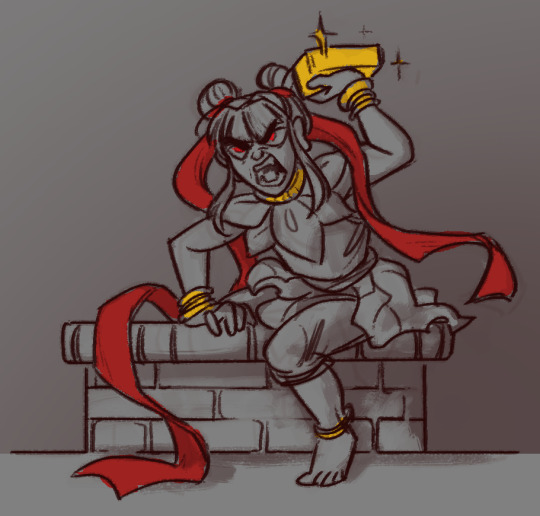
Nezha, but it's Truth Coming Out Of Her Well To Shame Humanity
just a little thing i cleaned up for shits and giggles
243 notes
·
View notes
Text
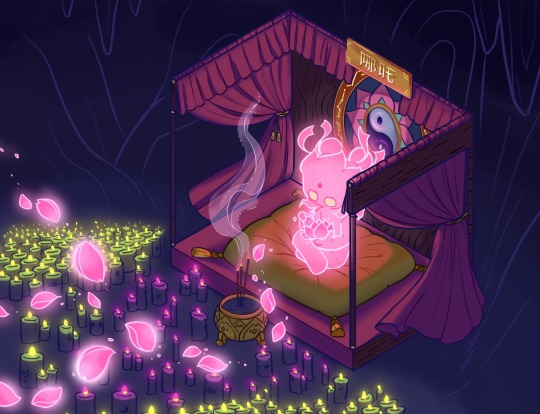

First altar 🕯
#my art#nezha#third lotus prince#prince nezha#fengshen yanyi#FSYY#investiture of the gods#everytime I look at the second picture I somehow think of amethyst from su#illurstration
843 notes
·
View notes
Text
the toll of being a middle child in this family is inconceivable
#nezha#jinzha#muzha#fsyy#jttw#please forgive the inconsistencies between frames OTL#really glad muzha was living his best life in jttw#still strikes me as the guy with too many accumulated pto days because he never takes them#working ot whenver a demon on the journey needs a thrashing#art tag
186 notes
·
View notes
Text
Out of all the fucking divine weapons out there…
He chose a fucking brick
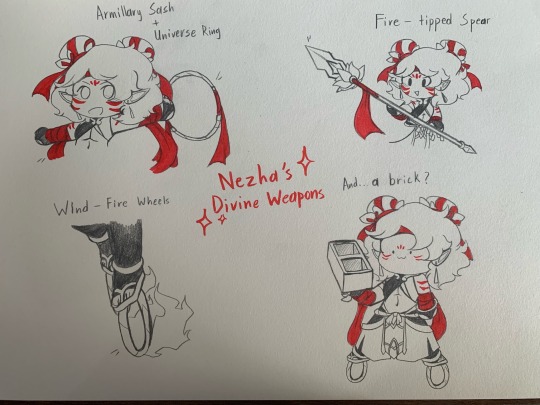
#nezha#li nezha#fensheng yanyi#fsyy#investiture of the gods#for the ones that you don’t know. yes. the brick is literally one of Nezha’s weapons. he actually used it to throw at Muzha lmao
102 notes
·
View notes
Text
Bad FSYY English translation
The four-volume Library of Chinese Classics bilingual edition of Creation/Investiture of the Gods (Fengshen yanyi, c. 1620) published in 2000 is the only full-length translation of the story available in English. I've had a PDF of the entire set archived on my external blog since May of 2020. It is serviceable for the general reader, but it is not great for hobbyist researchers like myself.
I'd like to provide an example showing how it is not very accurate and/or comprehensive. Chapter 12 describes how young Nezha inadvertently causes havoc in the underwater realm when washing himself in a river with a powerful magic sash. This eventually leads to Li Gen (李艮), a yaksha water-spirit soldier, to attack him with an ax. Gu Zhizhong's (2000) translation reads:
Nezha, naked and empty-handed, dodged the vicious blow, raised his Universal Ring and struck Li Gen on the head. How could the Yaksha withstand the magic weapon from Fairy Primordial! His skull broke open and he fell dead on the river bank (Gu, 2000, vol. 1, p. 239).
However, the full Chinese reads:
Standing there naked, Nezha dodged the advancing warrior's attack and upraised the Universal Ring in his right hand. This treasure was originally bestowed by the Jade Emptiness Palace of Mt. Kunlun to the Perfected Man of the Grand Monad to secure the items of his Golden Light Cave. How could the yaksha withstand the magic weapon as it struck downward on his head? His brains exploded from the blow, and he fell dead on the shore.
哪吒正赤身站立,見夜叉來得勇猛,將身躲過,把右手套的乾坤圈望空中一舉。此寶原係崑崙山玉虛宮所賜太乙真人鎮金光洞之物,夜叉那裏經得起,那寶打將下來,正落在夜叉頭上,只打的腦漿迸流,即死於岸上。
(I don't consider myself a translator, so please forgive any errors.)
You can see that quite a bit of information was left out. This happens throughout the entire novel. This makes me angrier the more that I think about. Why even bother to translate something if you are only going to paraphrase or even skip over passages? It seems like a pointless enterprise.
Source:
Gu, Z. (2000). Creation of the Gods (Vols. 1-4). Beijing: New World Press.

#Creation of the Gods#Investiture of the Gods#Fengshen yanyi#FSYY#English translation#bilingual#Nezha#Third Prince#Lotus Prince
51 notes
·
View notes
Note
Are there more stories about what demons Erlang has faced? Or more stories about him or where his character is included? I'm aware of Journey to the West, fsyy, the story with his mother and Lotus Lantern, but I was wondering if there were other stories where his character appears.
There are a lot of stories with him but they are more like legends than like narrative tales so to speak. Xiyouji, FSYY, and Lotus Lantern are novels and plays that allow full narratives that Erlang Shen features in but none really show the full extent of his character as he is more of a feature character than ever the protagonist.
Erlang's control of water is Erlang Shen's first and greatest achievement was water control and water control and made him a famous water god. With Erlang God's water control as the core, it radiates into legends such as killing dragons and slaying dragons.
Carrying mountains to catch the sun was from the Kaixi Period of the Song Dynasty, the "Inscription of the Induction of King Zhaohui Lingxian" describes the Erlang Shen as "the majesty of disturbing the mountain to take advantage of the sun, and the bravery of crossing the sea to capture the dragon.
The legend of Erlang Shen leading his divine soldiers and generals to search the mountains and succumb to demons can be found in the volume "Searching the Mountains", also known as the "Erlang Shen Searching the Mountains".
In the Five Dynasties, there is a legend about Erlang capturing an evil dragon. "Shu Shu": "The New Year's Banquet in June, "Guankou Divine Team" by Jiaofang Haiyu. The image of the two dragons fighting, the sky and the earth were dark for a moment, and there was heavy rain and hail. The Qing Dynasty's "Sichuan General Chronicle" locks the dragon: " It is said that Erlang locked the evil dragon in it. When frost falls and water falls, you may sometimes see it locked in the clouds."
In the Song Dynasty, there were a lot of themes of Erlang killing dragons. The Erlang who spent money usually rode an eagle and followed the dog. The entourage held a bow and stood a three-pointed two-edged sword beside him to subdue the dragon or the dragon transformed into a human body.
In the early days, Erlang Shen's divinity mainly came from Li Bing, who controlled floods. Guankou Erlang Shen controlled wind and rain, and Li Erlang's main deeds were also to capture dragons and control floods.
The "Stele Record of the Divine Blessing King" written by Zhou Hu of the Southern Song Dynasty (1170-1231) records that in 1206 AD, that is, the second year of Kaixi, Erlang Shen helped him fight against the Jin Dynasty and achieved a major turning point. Therefore, Emperor Ningzong of the Song Dynasty named Erlang Shen "Saint Martyr Zhaohui to protect the country".
As the belief in Erlang Shen spread widely, the priesthood of Erlang Shen also expanded as he was seen as a protector of the country's spirit. The "Nangong County Chronicle" of the Republic of China quoted Lu Zhongfu from Jin Zhangzong as saying: "In the autumn of the fifth year of Zhenglong (1160), the giant locusts covered the sky and ate all the acres. There were reports of hunger everywhere, the price of grain soared, and county people rushed to pray at the temple of Erlang Shen. The locusts dispersed and did not stay in the area. Fortunately, they were harmless at this time."
Erlang Shen is not only a god with vast supernatural powers and remarkable spiritual responses, but he was also regarded as the god of drama in the Ming Dynasty and was worshiped by Liyuan.
The Cuju industry also respects Erlang as the god of the industry and follows his character of playing games in the world.
Erlang God was revered as the "Lord of Sichuan" and became the god who protected the people of Sichuan from living and working in peace and contentment.
Song Zhang Tangying's " Sichuan Prayer " records: "(Qiande) in the second year of August, (Wang) Yan patrolled the north, and Prime Minister Wang Kai judged the guards of the six armies. The banners and flags were inexhaustible for hundreds of miles. Yan's military uniforms, Wearing golden armor, a beaded hat, and brocade sleeves, he holds a bow and carries an arrow. The people look at him and say he is like a 'guan-kou god'." Erlang Shen is equipped with a hound, an eagle, and a slingshot. It is a standard image of the hunting god, capable of restraining birds, beasts, mountain spirits, and wild monsters.
Because Erlang Shen carried a slingshot, he was attached to the function of delivering children by later generations. Because the slingshot is homophonic with "birth", it means birth. Almost every Erlang temple has people seeking children, which is the basic priesthood of Erlang Shen.
Tianqi was built in southern Fujian during the Chongzhen period of the Fengshan Ancestral Temple in the Ming Dynasty, the belief in Erlang Shen has formed a water god worship with strong local characteristics of southern Fujian in southern Fujian. There are now three statues in the Fengshan Ancestral Temple, which are called "Ambassador", "Second Ambassador" and "Third Ambassador", and "Ambassador" is the Erlang Shen in people's minds
I'm taking this all from his page so if you want a more detailed explanation I would suggest looking it into yourself because there is SO MUCH information about Erlang Shen being such a well-known figure and hero of legend that no way I can fit it all in one post but I hope this gives people an idea just how grand Erlang Shen's legend is and just how rich in both history and lore he is!
#jttw#journey to the west#xiyouji#ask#erlang shen#yang jian#sun wukong#lotus lantern#fengshen yanyi#fsyy#investiture of the gods#romance of the gods
32 notes
·
View notes
Note
Does Investiture of the Gods happen before or after Journey to the West? What about the Lotus lantern? Is there a chronological order to the stories? Which happens before or after?
Hello!
Technically Canonization of the Gods occurs before Journey to the West. Canonization itself is a heavily fantastical retelling of the collapse of the Shang Dynasty and the rise of the Zhou Dynasty, so figure around 1046BC, while Journey to the West is set in the seventh century - itself a fantastical retelling too.
However, it is extremely detrimental to assume the two are connected in any way, and this includes assuming the story of the Lotus Lantern to be related to the aforementioned stories. Canonization and Journey to the West were written down oral retellings by two very different people in two very different time periods. The ‘release’ of the Lotus Lantern was during the Tang Dynasty predating both Canonization and Journey to the West by a minimum of 500 years.
I understand the desire to want to make such connections though and have a well established timeline regarding the deities involved, but the fluidity of these stories and conflicting information within other external tales is a testament to the thousands of people who have listened to and retold such pieces of folklore.
Myself and @digitalagepulao were theorizing earlier about the sheer amount of story variation in China while Greek literature doesn’t seem to have many changes. Decidedly it’s a combination of sheer territorial expansion differences and Greek literature cases like the Iliad had actual lists of family names that needed to be maintained because any variation was seen as blasphemy; especially after the involvement of Christianity.
It is worth speculating on, especially for anyone involved deeply with the examination of various global mythologies and the many influences these belief systems were subject to. I hope this answer wasn’t too confusing, and thank you for asking!
#journey to the west#jttw#xiyouji#西遊記#canonization of the gods#investiture of the gods#fsyy#封神演義#封神榜#the lotus lantern#lotus lantern#the magic lotus lantern#宝莲灯#chinese mythology#chinese folklore#chinese literature
47 notes
·
View notes
Text
Anyone recognize this statue?
the ribbon makes me think Nezha but it’s hard to tell without the weapons and I could be totally off base.
also I got it at a local Antique Mall so they just had it labeled “warrior statue”



#chinese mythology#jttw#Chinese statue#antique#antique statue#Chinese antique#nezha#nezha statue#Putting those tags so people can correct me if I’m wrong#fsyy#investiture of the gods#journey to the west
12 notes
·
View notes
Text
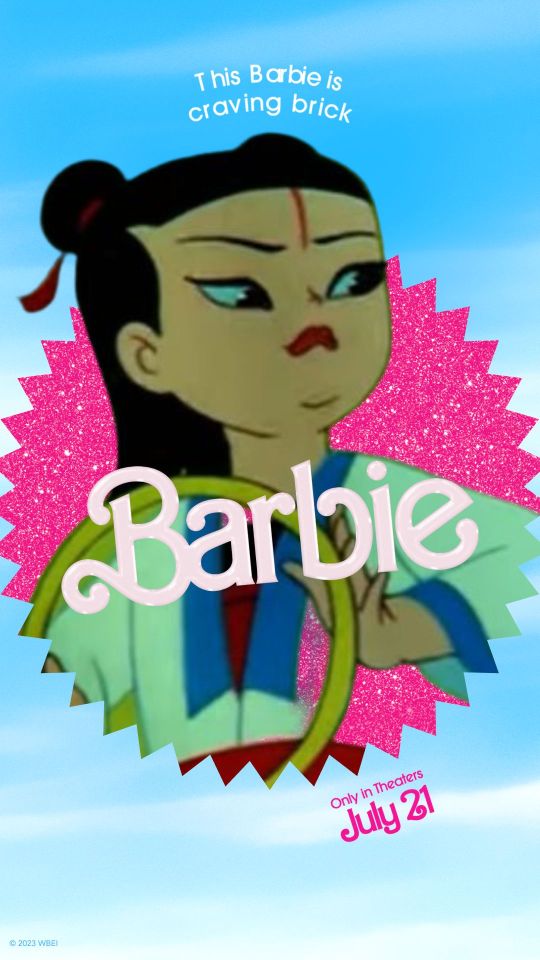
#nezha#li nezha#nezha conquers the dragon king#nezha 1979#fengshen yanyi#fsyy#investiture of the gods#barbie meme
22 notes
·
View notes
Text
Average jinzha enjoyer (I'm insane)

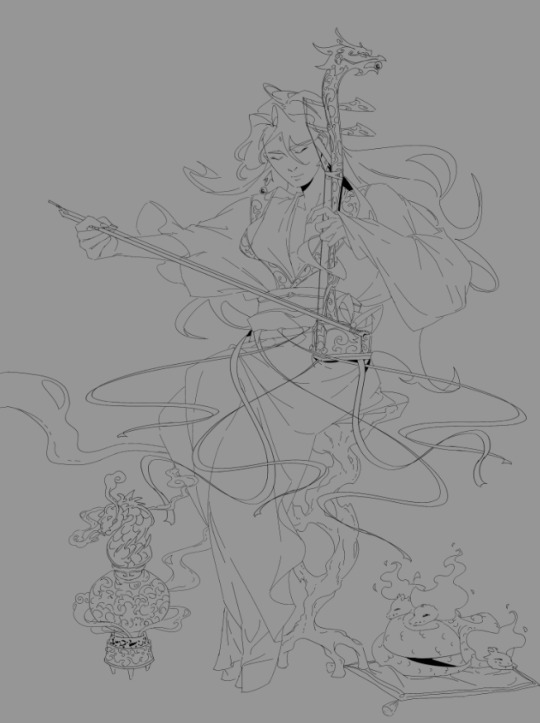

#jinzha#fsyy#art#my art stuff#muzha is not in the last pic because li jing forgot abt him <3#when i draw nezha my goal is to make him look like a cat that drank vinegar. i hope its clear
70 notes
·
View notes
Text
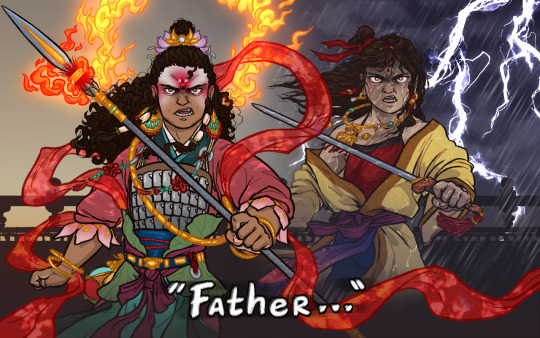
Prodigal son terror
Li Jing in a fury grabbed his halberd, leapt on his horse and galloped out of the headquarters. He was astonished to see Nezha with his Wind-Fire Wheels and Fire-Tipped Spear. He swore loudly, "You damned beast! You caused us endless suffering before your death, and now that you've been reborn, you're troubling us again!"
"Li Jing! I've returned my flesh and bones to you, and there's no longer any relation between us. Why did you smash my golden idol with your whip and burn down my temple? Today I must take my revenge!"
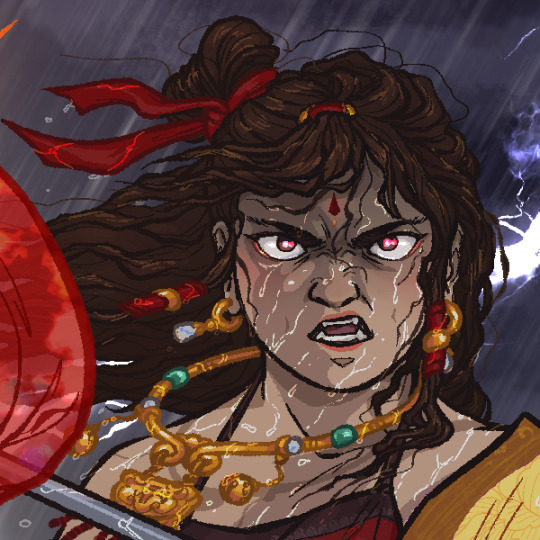

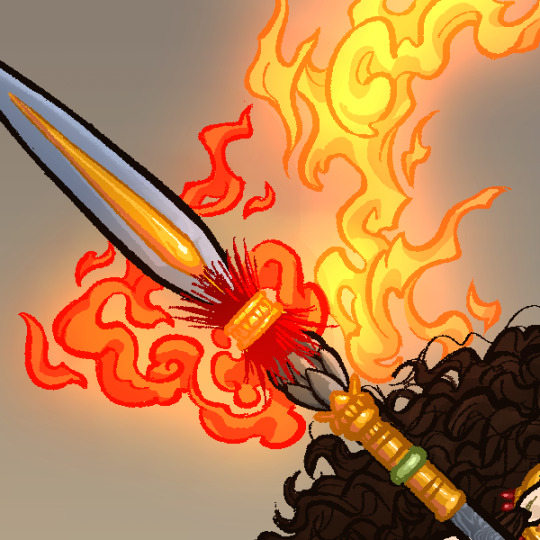

since I'm on a Nezha streak, might as well do my design for him on the Expedition AU! given that i've chosen to give characters a closer likeness to their region, it's only fitting i do the same with import deities like Guanyin, Subodhi and Nezha.
he's a complicated figure to place in the timeline because he gained popularity as a deity much after, only really arriving in China by the time the Journey would have been set. FSYY was written closer to when JTTW was written down, and he was retroactively inserted on the Zhou Dynasty period.
so deciding what to even do with him is dicey. but then i said fuck it, mythological rules apply here, he was around for the events of FSYY, and it and JTTW are set in the same universe. and for the sake of having some fun, i decided to get funky with his concept.
Nezha had the likeness of his family when he was alive, as described in FSYY, but once he was reborn with a lotus body he gained Indian traits instead. this is to be a nod to his status as an import deity and his origin as Nalakubara, and as the centuries roll by he may present himself to mortals closer to the locals' appearance wise.
as for his looks, i drew inspiration from multiple sources. read more for my rambles <3
his armor is closer to reconstructions of Zhou dynasty-period armor, skipping over extra parts simply because his lotus body is so indestructible, there's no need for a full set;
there are two red Chinese knots with jade beads dangling from the armor ties. they are said to ward off evil spirits, which felt like a good fit for a guy known to banish demons. i picked a six-petal flower pattern, which represents reunion, unity and a bright future;
i included lotus petals and leaves on his outfit as they are common in Beijing Opera outfits for him, and his makeup is a call to it as well;
The pink from the cheeks and eyeshadow seeps into his ear shell, as to convey the way sometimes, you get so angry even your ears blush;
Another thing i referenced from Opera is the two red ribbons on his sidelocks, though I changed them to two bulbs of lotus roots;
Four petals drawn close to his urna as both to make it look like a lotus but also form five petals, which is an auspicious number;
His hair crown is a fancy princely [knot] with a lotus motif and a pearl in the center, as he was the Pearl Spirit before becoming Nezha;
I was going to go with elf-like ears but I thought I could do better, so I went for stretched earlobes instead. you can't see it that well but hopefully the very large golden earrings imply it well enough xvx;
His cheek dimples are common sight on religious images of him and it was a cute touch imo;
Younger Nezha wears a golden robe because of his title as General of the Central Altar in Daoist belief, and the center direction is connected to yellow or gold, and yellow robes are usually meant for emperors and their sons, which is a minor nod to his self-assureness and boldness;
The Cosmic Ring has spiralling grooves on it both to catch blades on it for defense but also as a callback to Opera props;
On his waist is the embroidered ball weapon he was attributed with in earlier myths, he was also meant to have the leopard skin bag Taiyi Zhenren gave him, bjt it was going to be obscured by the text so i omitted it;
A few depictions of him gave him a halo of fire, which was real cool so i added it as well.
#fengshen yanyi#investiture of the gods#fsyy#iotg#li nezha#nezha#third lotus prince#third prince nezha#expedition to the west au#bell dragon art
322 notes
·
View notes
Text
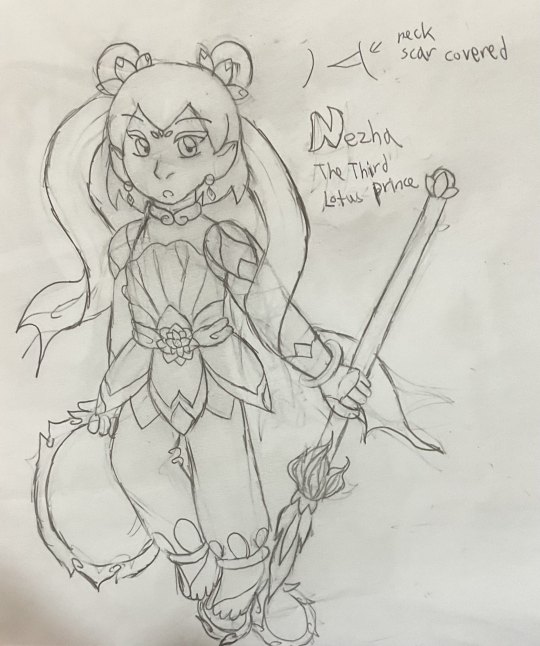
Oh hey i never shared my personal Nezha design! so here's a prince/marshal!
I tried incorporating a lot of lotus imagery (including the bud and the root) and I was also inspired by @antidotefortheawkward 's design here (theyre a huge inspo to me go follow them !!) and also various Nezhas on pinterest (i have a whole board of him...yeah)
btw he wears like a top under his lotus leaf chestplate sorry thats not clear
5 notes
·
View notes
Text
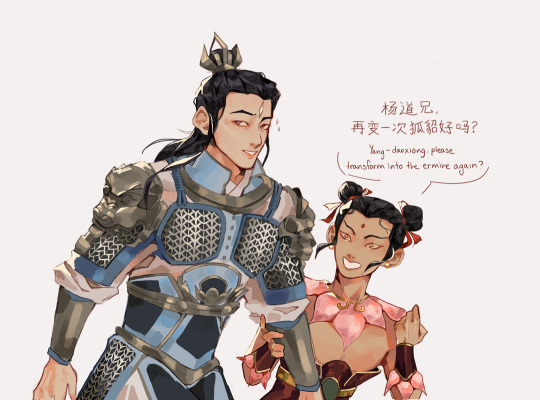
based on this :')

#fsyy#investiture of the gods#yang jian#nezha#erlang shen#usin the new gods desings heehoo#this is a fav right up there with the huang tianhua and nezha argue about getting their ass kicked by deng chanyu bit#把哪吒喜不自胜!!!😭#art tag
464 notes
·
View notes
Text
School doodle

Just the Li brothers cooking up some food
(Muzha would definitely be the leading cook since I hc’d him as a ✨Househusband Material✨ /j)
#li jinzha#li muzha#li nezha#fsyy#fensheng yanyi#investiture of the gods#jinzha | golden tactician#muzha | wooden scholar#nezha | third lotus prince#muzha is househusband material /j#also yes the food is based on one of the dishes you see in monster hunter world#idk why but i think’s it basically from my delulu ass imagining these three cooking like those cats whenever i watch the canteen cutscenes
48 notes
·
View notes
Note
What does Nezha's name mean? I tried looking at the SUPER RELIABLE Google translate and it told me the characters meant 'where' and 'upbraid' respectively, which doesn't make sense to me. Is Google *ghasp* WRONG or am I missing some cultural context?
Nezha (哪吒) is a sinicized and truncated version of Nalakūvara/Nalakūbara (Sk: नलकूबर; Ch: 那吒俱伐羅/那羅俱伐羅/那羅鳩婆).
You should contact @ruibaozha for more info.

43 notes
·
View notes